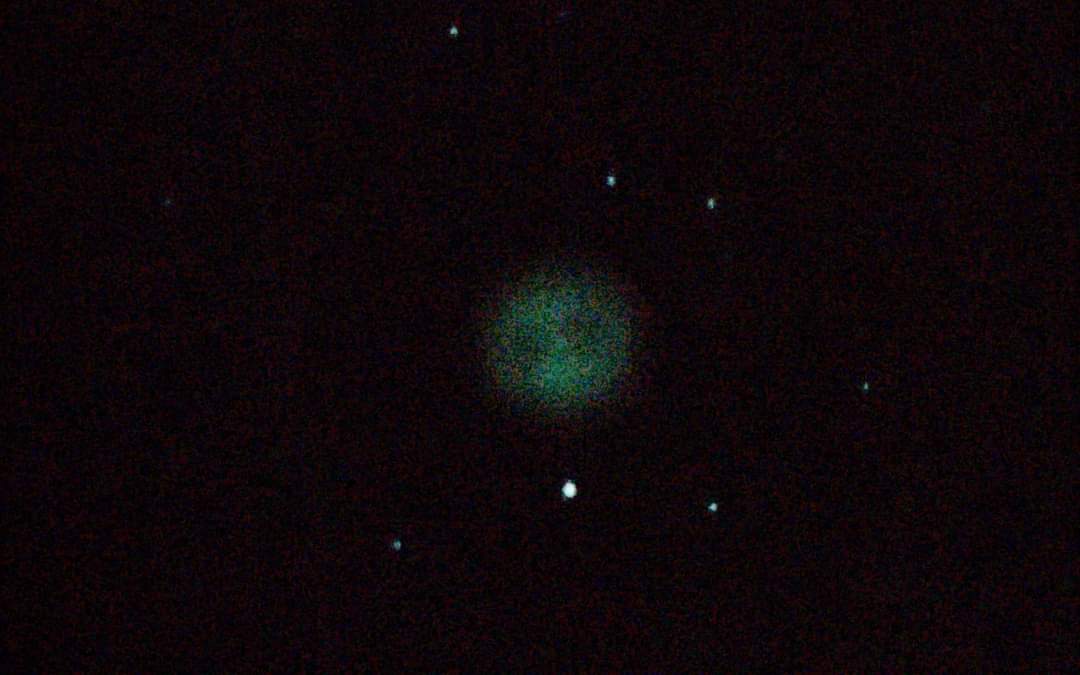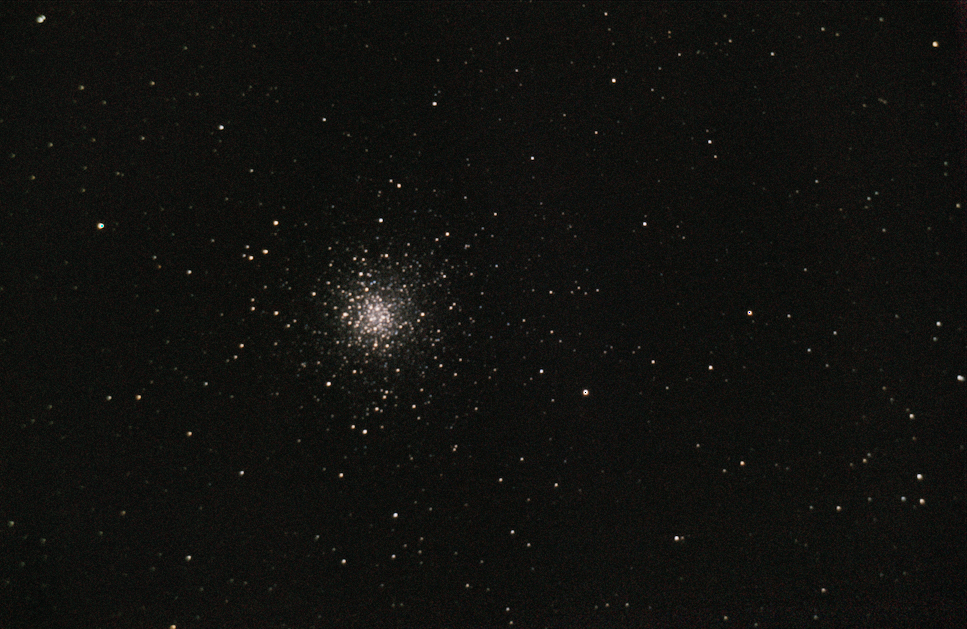-
Posts
31 -
Joined
-
Last visited
Content Type
Profiles
Forums
Gallery
Events
Blogs
Posts posted by Heskyyyyy
-
-
-
-
Two star clusters (can't recall their names, NGC something).
482 subs of 10 seconds each @ ISO1600
Quite surprised at the number of stars that were resolved using such a short exposure. I plan to image more galaxies when they come into my quadrant of the sky, so we'll see how the scope holds up and if the focal reducer makes a noticeable difference in detail.
-
 4
4
-
-
57 minutes ago, happy-kat said:
If it's in az mode with no wedge then it's not in EQ flavour. Have fun having as go.
I've not come across the starburst galaxy before, that was an interesting read up.
Yeah it's really faint. It's an Ha emitter, so couldn't really get much to show up.
-
-
M46 open cluster
190 x 10s exposures, ISO 1600
Stacked in Siril
Processed in Siril and GIMP
Canon t3i
I get star trailing after 10 seconds, and this is why I LOVE the focal reducer. Being able to gather MUCH more light in that short period of time.
So I think a good method to get semi-consistent stars is to shoot hundreds 10 second exposures.
-
 2
2
-
-
-
-
On 06/03/2021 at 22:56, scross86 said:
A first attempt at the Owl Nebula.
Taken with my Celestron 5SE with 6.3 focal reducer and Canon SL3 camera. Had a time with the gear but the main objective for the night was only getting more familiar with the Alt-Az Goto mount and sorting out a smooth setup process. I was aiming for 80 30sec subs, since I forgot to take away the 10 second countdown timer on the camera they were only 20 seconds each. Further shortened by Deep Sky Stacker having some trouble with the number of stars in the frame, I only ended up getting 23 subs to stack. ISO for the shots was 1600 and no calibration frames were used. So short integration time it just made the final photo worse. Lastly I used a 3 times drizzle to really emphasize the noise... I mean nebula.
Given the short integration time of only 7 min 40 seconds, I am pleased. A good point to work up from if there ever was one.
That's quite an amazing shot, considering that you only had 7 minutes of data. I think this is a great starting point, and if you pile on hundreds of more, it could bring out a LOT more detail with a lot less noise.
Good shot mate.
-
I'm curious to know just how much you can do without an eq mount.
Has anyone captured any extremely faint objects like Hoag's object?
And has anyone ever attempted exoplanet transit?
I'm dubious, but I'd love to know if anyone's tried any of these
-
-
I decided to re-process my shot of Messier 10, this time using Siril and GIMP. Siril has made processing a lot easier, and I've been able to pull out more detail than I'd expected for a 10 second exposure.
If you look closely, you can even see a few blue stragglers hanging around the core of the cluster.
I also recently acquired Celestron's f6.3 focal reducer, so when I'm able to, I'll be able to continue wrestling with this hobby, with slightly less headaches.
To those who HAVE the 6.3 reducer, has it made a noticeable difference with exposure time/light gathering ?
-
 3
3
-
-
11 hours ago, Filroden said:
The single biggest tip for post processing Alt Az images is to crop. Crop heavy! You need to remove all the stacking artefacts caused by field rotation before doing any other post processing otherwise it will be a nightmare. And those artefacts can reach far into an image so really stretch the image to see them, undo the stretch and make sure to crop inside.
Of course, the single biggest top for pre-processing any image (alt-az or eq) is use flats and either darks/flat-darks (for cooled cameras) or bias/bias (for uncooled cameras).
The goal is to get your starting stacked image to be as clean as possible to make the rest of the processing easier, especially gradient removal and colour correction.
Will do. Thanks

-
I just want to say thank you y'all for the tips so far on post processing. I'm likely to be getting an eq mount by summer next year, so these tips will totally come in handy. Please keep it up

-
2 hours ago, Nerf_Caching said:
Wow nice picture you've got there! I hope you don't mind but I took the liberty to download a png of your picture and did some further processing myself using Siril and GIMP. I first did a background extraction in Siril to remove the gradient on the picture. I then transferred it to GIMP to crop the stacking artefacts, remove the color cast with curves and finally performed a slight desaturation of the background. There are residual artefacts on the upper right but that can be easily cropped. Keep up your good work!
Not at all! Very very nice

-
 1
1
-
-

Messier 10 Globular cluster, with 115 x 10 second subs at iso 3200, moon very nearby. A bit of amp glow in the bottom left I just noticed, so gotta keep an eye on those in the future to crop out. I'd say this is a very big improvement from my messier 3.
-
 1
1
-
-
4 hours ago, Stub Mandrel said:
Hi, hope you don't mind, I took a screen grab of your image and pasted it as an image in Photoshop.
I cropped off the dotted line, created a mask to exclude the galaxy and ran gradient exterminator. This balanced the background colour to a neutral dark grey.
Then I applied a flattened S-shaped curve to brighten the faint parts fo the galaxy (but not the very darkest bits) while not blowing out the stars. You need to experiment.
Then I ran an 'increase star colour' action 2 or 3 times.
It coudl do with noise reduction and tweaking to smooth the background, but you get the idea.
It's worth you persevering with your original data, 99% of the hard work is processing!
Wow that looks beautiful, and thanks for the tips!

-
 1
1
-
-

Cigar Galaxy, with 17 minutes worth of exposures.
-
2 hours ago, Nerf_Caching said:
Do you have the unprocessed stacked file? Maybe we can help you out with processing. What was the total integration time?
About 18 mins. I use GIMP to process. For all of y'all too, y'all have any tips for better results? I live far up north such that it never gets completely dark at night in the summer, and a target in the North really shows that blue.
-

Bode's Galaxy. Avoiding Polaris as an alignment star was extremely wise, as I was able to get all 15 second exposures (ISO 1600) with minimal to zero trailing. 71 subs. Target was to the North, so I couldn't really get rid of the blue background, or maybe I'm just bad at processing 😛
-
 4
4
-
-
1 hour ago, JonCarleton said:
I usually shoot 10 second exposures, but I get lots and lots and lots of subs. While I do recognize that 100 10 second subs does not equal 10 10 minute subs, it probably comes close to half the light of a long exposure collection. After stacking, I get pretty good light density....and all but eliminate the shortcomings of my Alt/Az tracking.
Very encouraging. I think if possible I'll get data of the same target over multiple clear nights.
-
 1
1
-
-
-
1 hour ago, The Admiral said:
My, possibly spurious, understanding is that when you perform an alignment what you are doing is getting a fix on where stars are at a point in time, so that the 'model' is calibrated. But Polaris doesn't change position with time, and so is rather less than helpful in getting a 'fix'. I would not recommend using Polaris for alignment. I also try to align on stars which are approximately 90° apart in azimuth, as it strikes me that using orthogonal axes would improve the precision. I choose bright stars between 40° and 60° altitude as well as separated by about 90° in azimuth. In addition I always level the mount so as to minimize the corrections that have to be made to get the model 'fixed'. I normally just used a 2-star alignment.
Ian
Thanks a lot for the helpful advice. I'll try to avoid Polaris next time I can get out. I'll also keep playing around with exposure times to try to find the ultimate limit for my telescope.
-
23 hours ago, The Admiral said:
What mount are you using to track the heavens? The maximum exposure I've used with my NexStar Alt-Az is 30 seconds without getting too many streaky subs, though others have managed to use a little longer. At the end of the day though you will be limited by physics, in that you will get field rotation. Lowest towards the East and West, and worse as you increase altitude towards the zenith. I used to limit it to 60°.
Ian
Which stars did you use to align the nexstar normally? I'm thinking the reason my subs are so short are because I usually use Polaris as an alignment star.
Thanks























The "No EQ" DSO Challenge!
in Getting Started With Imaging
Posted
Thank you 😀 I really didn't want to blow out the core because those dust lanes are just TOO BEAUTIFUL